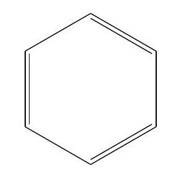
Now that we have studied the classification of hydrocarbons, let us go through the concept of aromatic hydrocarbons. Their high stability nature is what makes them unique and distinguishes them from the rest. This highly stable nature is possible because of their ring-like structure. Also known as arenes, possess unique chemical properties due to their aromatic property.
Interested candidates can continue reading the article for more details related to aromatic hydrocarbons.
- Structure of Aromatic Hydrocarbons
- Huckel’s Rule of Aromaticity:
- Nomenclature of Aromatic Hydrocarbons
- Properties of Aromatic Hydrocarbons
- Class 11 Chemistry NCERT Solutions: Chapter Wise
Structure of Aromatic Hydrocarbons
Talking about the structure, aromatic hydrocarbons are cyclic in looks with alternating double bonds between the atoms. Benzene is known to be the simplest aromatic compound. Each carbon atom in benzene is spš hybridized and forms bond angles of 120 ř. Delocalized π electrons are spread all over the surface of benzene.
Huckel’s Rule of Aromaticity:
According to this principle, a compound is considered to be aromatic if it fulfils the following conditions:
- It is fully conjugated (alternating single and double bonds with delocalized π-electrons).
- It has (4n + 2) π electrons, where n = 0,1,2,3 ……
- It is cyclic and planar
Examples: Benzene, Naphthalene, Cyclooctatetraene, etc.
SInce benzene has 6 -electrons ( ), it is considered to be aromatic and stable. But on the other hand, cyclobutadiene has 4 electrons (4n), so its anti-aromatic and unstable.
Nomenclature of Aromatic Hydrocarbons
Following the footsteps of the IUPAC Rules, naming the compound also involves one additional step, taking benzene into account as the parent name. This is the core and necessary step, without which you cannot name any aromatic compound. The rest of the procedure depends on the exact number of functional groups or substituents added to the benzene.
- In case of a single group, the name of the compound can simply be written as substituent + benzene. Example: Toluene, also known as methylbenzene.
- In case of multiple groups, assign a number in such a way that these functional groups get the lowest possible number. Then list all these substituents in alphabetical order.
Properties of Aromatic Hydrocarbons
Aromatic hydrocarbons possess some unique properties due to their aromaticity. These properties are mentioned as follows:
Physical Properties:
- Aromatic Hydrocarbons dissolve in organic solvents like ether instead of water. This is called having a non polar nature.
- Benzene is a liquid at room temperature, having a boiling point of 80 ř C and a melting point of 5.5 r C..
Chemical Properties:
Instead of going for the traditional addition reactions, they prefer to go for substituent reactions due to having stable nature.
- Electrophilic Substitution:
Benzene forms nitrobenzene.
Benzene forms chlorobenzene.
- Friedel-Crafts Reaction: Benzene reacts with alkyl halides or acyl chlorides in the presence of :
Benzene forms toluene.
- Combustion: Aromatic hydrocarbons burn in oxygen, but often with a sooty flame due to high carbon content:
Class 11 Chemistry NCERT Solutions: Chapter Wise
Chemistry Hydrocarbon Exam
Student Forum
Other Topics under this Chapter
Other Class 11th Chemistry Chapters
- Chemistry Chemical Equilibrium
- Chemistry Structure of Atom
- Chemistry Redox Reactions
- Chemistry Some Basic Concepts of Chemistry
- Chemistry Organic Chemistry
- NCERT Class 11 Chemistry
- Chemistry Classification of Elements and Periodicity in Properties
- Chemistry Chemical Bonding and Molecular Structure
- Chemistry Hydrocarbon
- Chemistry Thermodynamics

